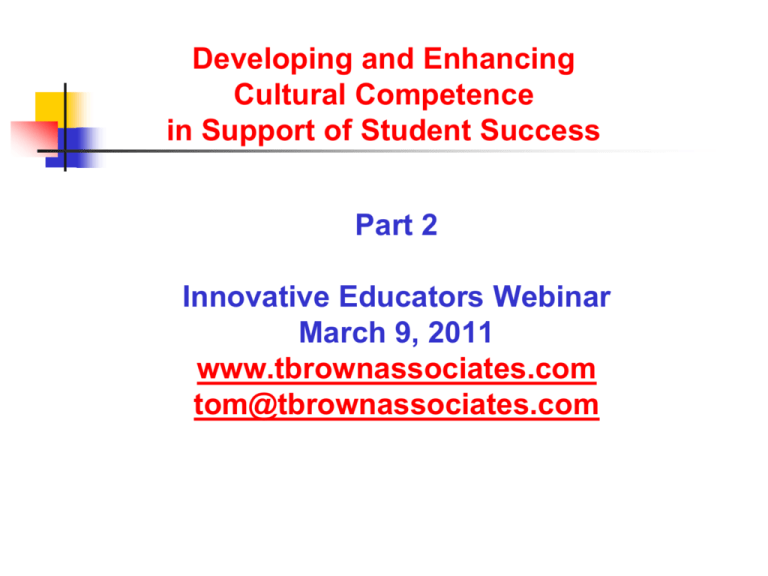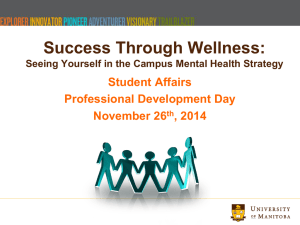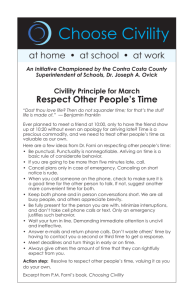Perhaps the greatest inequity in our nation's schools is the unequal
advertisement

Developing and Enhancing Cultural Competence in Support of Student Success Part 2 Innovative Educators Webinar March 9, 2011 www.tbrownassociates.com tom@tbrownassociates.com Imagine a school where all kinds of people feel comfortable showing up, secure in the knowledge that they have a place they don’t have to defend every time they turn around, where they are encouraged to do their best, and are valued for it…. Privilege, Power & Difference Allan G. Johnson, 2006 We are an inclusive community, in which students, staff, faculty members, and alumni feel welcome, respected, valued, and empowered to contribute fully. University of Lethbridge USD is committed to creating a welcoming, inclusive and collaborative community characterized by a rich diversity of people and ideas. The university values students, faculty and staff from different backgrounds and faith traditions, and is committed to creating an atmosphere of trust, safety and respect. Core Values University of San Diego DiversityInclusivity Diversity is a reality of the human experience; the question is what we do with the diversity we encounter in our lives. The issue today seems to be less about diversity and more about creating inclusive communities from diverse individuals and groups. Workshop Overview What does it mean to be an inclusive campus community? What challenges are confronted by students who experience exclusion on campus? How can colleges create more inclusive and civil campus communities? An Inclusive Campus Are places where students and faculty work together to create an environment in which everyone feels safe, supported, and encouraged to express her or his views and concerns. In such settings, faculty seek to be responsive to students both on an individual and a cultural level. Shari Saunders & Diana Kardia CRLT, University of Michigan DiversityInclusivityCivility Civility matters because treating one another with respect is necessary to effective communication, community building, and finding common ground. Dr. Cindy Clark DiversityInclusivityCivility In keeping with the tradition of our Franciscan founders, welcoming everyone we encounter as an honored guest…. Core Values Viterbo University DiversityInclusivityCivility We will support each other and work together toward the common good. Statement of Values Lenoir Rhyne University A Global Issue Schools with an inclusive orientation are the most effective means of combating discriminatory attitudes and creating welcoming communities, building an inclusive society and achieving education for all. UNESCO Salamanca Statement, 1994 What does it mean to be an inclusive campus community? Are there instances where inclusivity might be contrary to your institution’s mission? What would that mean for the individual educator? For students? Do campuses have an obligation to be clear about aspects of their mission, vision, and values that are exclusive? The American college campus is one of the very few places on earth where people from so many diverse backgrounds come together for a common purpose. Diversity expands worldliness. Whether we like it or not, many times we find ourselves segregated from other groups in schools, churches, and our own neighborhoods. A college campus is like opening the door to the entire world without traveling anywhere else…. Why Does Diversity Matter at College Anyway? US News and World Report , August 12, 2009 Pre-college experiences of US students * Public universities ** Private universities >71% grew up in neighborhoods that were “mostly or completely white.” 61*-65%** attended high schools that were “mostly or completely white.” 15% grew up in neighborhoods that were “mostly or completely non-white.” 13**-16%* attended high schools that were “mostly or completely non-white.” 2009 CIRP Freshman Survey Student expectations Students entering college often expect that they will have opportunities to interact with people from different backgrounds, but research finds this is usually not the case. Foundations: A Reader for New College Students, 2010 Will students “sit together in the cafeteria” without faculty/staff leadership? Seven kinds of diversity Beverly D. Tatum, 1999 “Otherness” Race/ethnicity Gender Religion Sexual Orientation Socio-economic status Age Physical/Mental Ability “ism” Racism/ethnocentrism Sexism Religious oppression Heterosexism Classism Ageism Ableism Multicultural students Often experience being minorities for the first time on predominantly white campuses, where they often encounter negative stereotypes, marginalization, and low expectations from faculty, staff and peers. African American students are more likely to find faculty members remote, discouraging, and unsympathetic. ”Exploring Distinctions in Types of Faculty Interactions Among Black, Latino/a, and White College Students” Cole and Anaya, 2001 Stereotype Threat Arises when students of color are in situations where their performance could result in their being reduced to a stereotype, where they could be judged by a stereotype; where judgments about them could be made based on a stereotype. Professor Claude M. Steele Stanford University, 1995 Stereotype Threat Sets up a mutually reinforcing system, the fear of confirming the stereotype leads to behavior that confirms it. Individuals do not have to believe the stereotype to be true for it to influence their behavior. Hyde & Kling, 2001 Effective Strategies Transition programs—summer bridge, culturally relevant orientation programming, Inclusive curriculum and co-curriculum Learning communities Diverse faculty and staff Expectation of “cultural competence” for all faculty and staff Gender Issues Most faculty are very supportive of women’s presence in their courses. However, some faculty unconsciously support an atmosphere unfriendly to women. Susan Montgomery &Martha Cohen Barrett Stereotype threat has also emerged as a possible cause of the inequalities women face upon entering majors and careers dominated by men, such as science, math and engineering Steele, James, & Barnett, 2002 Objectifying glances subtract from women’s math performance. Chronicle of Higher Education February 4, 2011 Gender Issues: Creating an Inclusive Classroom (Derek Bok Center for Teaching and Learning Harvard University) Observe the gender dynamics in your classroom, especially at the beginning of the class. Know your students individually, their attitudes and the reasons for their silences and respond accordingly. If they are quiet but engaged, an encouraging gesture may be all that is needed to include them. If they are being intimidated or interrupted by others in the class, your protective intervention may be called for in a way that gives them strength. If they are alienated or hesitant by nature, find ways to show that you are especially interested in what they have to say. Gender Issues: Creating an Inclusive Classroom To create openings for reticent women, you might try to: Ask students all to take turns at presenting material. Assign them to small groups to solve a problem. Give students time to answer. Refer back to the comment of a quiet woman to make it a pillar of discussion. Refer to a silent student's written work in an affirming way. Resist filling every uncomfortable pause with your own voice. Derek Bok Center When students perceive that college faculty and staff hold high expectations for their success, they often will rise to meet those expectations. McClenney (forthcoming, 2011) Students with Disabilities These students are routinely stereotyped as helpless and inferior human beings, who lack the ability to succeed and are routinely denied opportunities to develop their abilities. Johnson, 2006 For many students with disabilities, college is an initial experience wherein personal responsibility and independence become critical. Steven Ender & Carolyn Wilkie, 2000 Educators must stress the importance of personal assertiveness [and] work actively and systematically when addressing the area of developing or validating life purpose. Ender & Wilkie, 2000 Increasing Success: Students with Disabilities Encourage and support students to: Seek out assistance when they need it Learn how they learn and be active learners Create effective study routines Start early, don’t procrastinate Identify problems that repeatedly get in their way. Understand and use campus and community resources Self advocate Adapted from: Survival Guide for College Students with ADHD or LD Kathleen G. Nadeau What are some assumptions that could serve to undermine the achievement of women, multicultural students, or students with disabilities? First generation/Low SES Students Students from low socioeconomic backgrounds may experience stereotype threat on intellectual tasks compared to students from high socioeconomic backgrounds. Source: ReducingStereotypeThreat.org 40% of first-generation students leave college without a degree….they are more likely to come from low income families. US Department of Education, 2005 77% of high income students 54% of low income students graduate in six years. One Step From the Finish Line The Education Trust, January 2005 First-generation status appears to be a disadvantage throughout postsecondary education that is independent of other background and enrollment factors. Choy, 2001 Students from Rural Backgrounds Little attention is being paid to the unique group of rural first generation students who are currently entering our community colleges and universities. Rural youth are also moving to a place where fewer strangers can be trusted. Finding common ground can be hard. Stereotypes of rural people as "bumpkins," "hillbillies," or "cowboys" may present themselves, forcing these youth to either hide their roots or prove themselves in and out of the classroom. “The Long Road to College from Rural America” Devorah Shamah, www.education.com What practices have you found to be effective in supporting students who are first geneartion/Low SES? Increasing Success: First Generation/Low SES Continuous advisor/advisee contact throughout the first semester/year Proactive referrals to sources of assistance and support (e.g., tutoring, instructional labs, counseling, career services) Outreach to help students feel comfortable on campus and to encourage their involvement LGBT are “among the most despised groups in the United States today….” Blumenfeld, 2003 Nearly a quarter of gay, lesbian, bisexual, and queer students and employees have experienced harassment at their college, and more than half had observed or perceived it. Q Research Center for Higher Education, September 2010 Issues for LGBT College Students Maintaining self-esteem and coping with being “different” Deciding whether to “come out” to family and friends Facing intolerance, harassment, and violence Greatest risk for suicide and other health issues Lack of role models Sanlo, 2004 Effective Strategies Mentoring Creating “Safe Zones” and developing Allies Links to Career Development Spiritual and Faith Formation issues Others?? Jennifer Joslin, 2007 Best Practices Provide orientation and training re: LGBT issues, concerns for Campus security Health Center Residence Life Counseling Center Career Services New Students Athletics Dean of Students (Source unknown) DiversityInclusivityCivility Creating inclusive campus communities requires challenging and supporting students, faculty and others who are in dominant groups to see those in subordinate groups as “us” rather than “them” Creating Unum from the Pluribus Seven kinds of diversity Beverly D. Tatum, 1999 “Otherness” Race/ethnicity Gender Religion Sexual Orientation Socio-economic status Age Physical/Mental Ability “ism” Racism/ethnocentrism Sexism Religious oppression Heterosexism Classism Ageism Ableism The Diversity Wheel Work Role Education Parental Status Age Sexual/ Affectional Orientation Race Marital Status Physical abilities/ qualities Geographic Location Diversity Wheel Income Ethnicity Gender Religious Tradition Military Experience Workforce America, Loden & Rosener, 1991 Describe yourself using the inner wheel My age: My race(s): My gender: My ethnicity/ethnicities: My sexual/affectional orientation: My physical abilities/disabilities: Describe yourself using the outer ring Education: Income/SES: Parental status: Work role: Marital status: Military experience: Religious background/tradition: Current geographic location/base: Work Role Education Parental Status Age Sexual/ Affectional Orientation Race Marital Status Physical abilities/ qualities Geographic Location Diversity Wheel Income Ethnicity Gender Religious Tradition Military Experience Workforce America, Loden & Rosener, 1991 Diversity Wheel Exercise Imagine you awoke this morning and your [gender, sexual orientation, race, religion, age, physical abilities] had changed. How might this change affect how others perceive you and treat you? Family Friends Co-workers Community-at-large Diversity Wheel Exercise How might the change affect the material circumstances of your life, such as where you live or how much money you have? In what ways might your life be better? In what ways might your life be worse? Questions to consider How could the Diversity Wheel exercise be used in a curricular or co-curricular setting? What kinds of critical thinking or other skills might be enhanced through such an exercise? Faculty have the added responsibility of inculcating students with professional values, and ensuring that they are prepared for positions of responsibility in their selected fields. Barrett, Rubaii-Barrett, & Pelowski Journal of Public Affairs Education, Fall 2010 Creating a culture of civility requires communication, interaction, and an appreciation for the interests each person brings to the relationship. The Dance of Incivility in Nursing Cynthia Clark, 2008 Higher-education institutions are simply microcosms of the world around them. To the extent that the world includes incivilities, it should come as no surprise that we will encounter incivilities on campus… Silverman, 2008 Student incivility 1. 2. 3. 4. Can be grouped in four categories, according to the level of severity: Simple annoyances, Intimidation “Classroom terrorism” Threats of violence “Classroom civility is another instructor responsibility” Lloyd Feldman, 2001 Factors contributing to student incivility Psychological pathologies Racist and misogynistic beliefs The lack of consequences for misconduct Understanding Student Development William Perry’s Schema (1970) Among the developmental stages: Dualism: All questions have a single right answer and teachers can tell you what is true. Multiplicity: There is no known truth. Where authorities don’t tell me what is true, my opinion is as good as any other. Relativism: There are several approaches to an issues, which are not equally valid in all situations, and context has an effect on the validity of knowledge. Understanding Student Development William Perry’s Schema (1970) Commitment: Making choices and decisions regarding one’ position on controversial issues (e.g., gay marriage, abortion, affirmative action) based on values students have chosen, rather than on those made by others (e.g., parents, peers, or other “authorities.” Issues never get settled; new knowledge replaces old beliefs; context of knowledge and values changes and evolves. Understanding Student Development: From theory to practice Catherine comes to her advisor claiming that she feels “harassed” because her teacher will not include a discussion of creation science in her biology course. There is also a “nonbeliever” in her course who laughs at her whenever she expresses her beliefs How could Perry's schema be helpful for an educator seeking to assist Catherine? What advice would you give Catherine about the student who laughs at her? A safe classroom climate A safe classroom is one where discussion and disagreement are acceptable; where established rules of discourse are followed by everyone, especially the instructor. 2. Students may need to be reminded of ground rules from time to time 3. Once students have reached consensus on a particular point, acknowledge this and agree to move on, so they don't recycle arguments over old ground. 1. University of North Carolina Center for Faculty Excellence A safe classroom climate It may be necessary to call “time outs” to allow emotions to cool. Ask students to summarize the discussion and write down their own thoughts, so these can be shared to restart the discussion. 5. Reserve time to wrap up the discussion, wherein students report what they learned and examine conclusions drawn from the exchange. 4. University of North Carolina Center for Faculty Excellence In an undergraduate context, it is widely accepted that the foundation of a civil or uncivil classroom is established within the first four days of class Hirschy & Braxton, 2004 Civility Contract-Indiana University (http://www.esf.edu/facgov/ExecChDocs/civpldge.pdf) The classroom setting must be characterized by appropriate, respectful behavior. No instructor nor other students in a class should be subject to any student’s disruptive or rude behavior. The instructor will take appropriate action to maintain a positive learning environment. Sanctions may include removal from class, failure of an assignment or the course, and/or referral to the campus judicial system. Likewise, no student should feel disregarded or intimidated by his/her instructor. As a member of the academic community, I understand my responsibility for ensuring a productive and conducive learning environment. I will respect the guidelines listed above and I understand the consequences of disregarding them Signature Printed Name Date Six themes of faculty to student incivility 1. Faculty making condescending remarks 2. Using poor teaching style or method 3. Using poor communication skills (e.g., “surprise” grades, no syllabus) 4. Acting superior and arrogant 5. Criticizing students in front of peers 6. Threatening to fail students Clark & Spring, 2007 Civility in the College Classroom Jennifer Schroeder & Harvetta Robinson, 2008 Be proactive: Include expectations for behavior, along with academic expectations in syllabi Be a model: Behavior serves as a powerful representation in how faculty treat students Ask why: seek to have students explain their behavior and put it into context Have a plan: to respond to the unexpected Follow through on your plans for action Document incidents and your response(s) thereto Comments Questions Effective strategies EVALUATIONS http://www.smc.edu/Projects/336/SMC_Workshop_Evaluation_Form_Inclusivity_WEBINARS_ONLY_Editable.pdf






